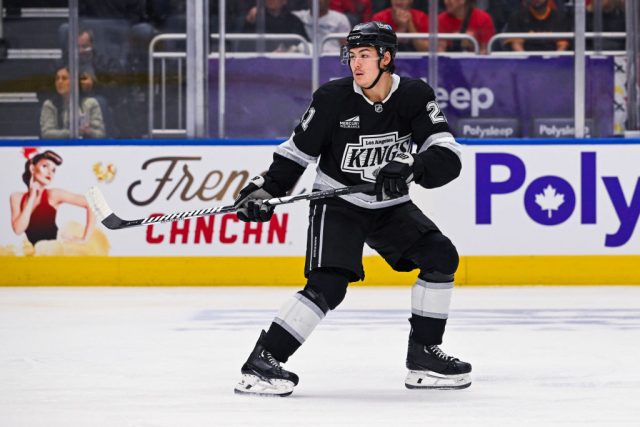1, here comes the 2 to the………2.
From the first day of training camp, we knew we’d see something a little bit different from the LA Kings this season.
Anze Kopitar wasted no time ripping off the Band Aid – stating that the 1-3-1 was no more, with Adrian Kempe filling in some additional information, stating that the Kings will transition to a 1-2-2 in the neutral zone this season.
Thus ends an era. An era mostly made into an era any time the Kings played in Canada and defeated a Canadian team. But an era nonetheless.
All the way back on the first day of camp, Jim Hiller spoke about the neutral zone as a way to get the team’s forward moving a little bit more. No reminder needed on the infamous “standing still right winger” comment from exit interviews.
The 1-3-1 was certainly a part of the identity the Kings built over the last few seasons. You can’t say it wasn’t a part of the team’s success in transitioning from a team at the bottom of the standings to a playoff team three years running. Typically, any time you hear an opposing team comment on systems, it’s out of frustration.
While it’s no longer the primary option, it’s not like the concept has been forgotten, either. If the Kings need it, it’s there. But, with the personnel in place right now, Hiller believes that the best way forward for the Kings was to make a change in that area. It’s not meant to be a change away from a strong, sound defensive team, but a change that could hopefully fit the way the current roster is constructed.
“I think the 1-3-1 was a very effective system, I thought the guys played it very well, we just think with where we’re at now, as a franchise, it’s time to make an adjustment, to see if we can get our forwards to skate a little bit more” Hiller said, early in camp. “Hopefully we get better results because of it.”
As the Kings have progressed throughout training camp, the comfort level has risen within the system. It impacts the forwards, defensemen and goaltenders all a little bit differently.
Okay, maybe not really the goaltenders. Darcy Kuemper comes to the Kings from Washington, a team that did not play a 1-3-1 last season, while David Rittich was inclined to believe the change could benefit the group he sees in front of him.
“We’ve had enough practices to figure out what’s going to be important in our system, for the goalies, and some things we already knew,” Rittich said. “I think it’s good. I personally feel like we have a really fast team and a 1-2-2 is just going to help us.”
In terms of the skating ability, the Kings certainly have it, especially on the wings.
In the top nine, down the right side, the Kings have Adrian Kempe, Trevor Moore and Warren Foegele, who are all strong skaters.
For Kempe and Moore, both players came from the 1-3-1 and are learning this system for the first time, if you will, although I don’t think there’s a professional hockey player in the world who hasn’t played a 1-2-2 in the neutral zone. Drew Doughty said as much prior to his injury. Even I learned it with the Shaker-Colonie Jets high school team back in 2009, so I’m certain that those guys can pick it up.
Both acknowledged the learning curve, but both also agreed that the change in system speaks to the speed that players like them, and others, can use within that system.
Kempe – It’s learning a new, complete system for the team, but I think we’ve created a lot of turnovers, a lot of chances from it. I’m excited for it, I think it’s going to be fast, I can use my speed and skill even more and hopefully it’s going to turn out good.
Moore – It feels a little bit more intuitive out there, a little bit more forward skating. You can attack better. I think it’s been good so far. There was definitely stuff you have question marks on, but we’ll get it going.
Moore highlighted the system’s ability to get the feet moving for players like him on the wing, to better capitalize when the system executes as intended. It gets players skating, as opposed to waiting, so when a turnover comes, it’s a created with forwards already moving. There’s benefits to that with regards to potentially going the other way.
I think part of the change too comes down to the players the Kings have on the right. Kempe, Moore and Foegele are all penalty killers and none of them cheat the game for points. The Kings were a Top-5 defensive team around the NHL last season in just about every category. Whether it was goals against, suppression of high-danger chances or anywhere in between, the Kings ranked in the league’s Top-5 in 5-on-5 situations.
They don’t want to lose that, but they also understand that the offensive production hasn’t been to where it needs to be in order for the organization to take the next step. Having the right mindset, with the right system change, is something the Kings hope can help one without hurting the other.

Photo by David Kirouac/Icon Sportswire via Getty Images
With regards to the defensemen, there are multiple changes.
In past seasons, the Kings prioritized fast, puck-moving players on the right side because they fit into how the 1-3-1 was aligned.
Doughty was already there, but frankly he can play in just about any role and be successful. Think Jordan Spence and Brandt Clarke, as puck retrievers, those are the guys who handle pucks well, with the right defenseman always the furthest player back.
Even guys who have recently departed the organization were strong puck movers, guys like Sean Walker and Sean Durzi had those areas as strengths, whether it be Walker with his legs or Durzi in moving the puck.
The right-sided defensemen now have different responsibilities. Puck retrievals will still be key, but there’s more variance.
“I think we’re way more aggressive this year,” Spence said. “For the right D, we were always staying back, trying to retrieve the puck, but this time we’re trying to step up to guys before the blueline. It’s a big change, but at the same time, I think it’s going to create a lot of opportunities in the offensive zone, turn the puck around as fast as possible. I think for us, it’s going to work out really well and for me to jump up and contribute.”
For those who play on the left side, the Kings typically looked for that more defensive player, perhaps with some physicality, as the left-sided defenseman was up on the left side as a part of the three across.
For Mikey Anderson, the 1-3-1 is more or less how he came into the professional ranks. Playing that system for four consecutive seasons turned it into clockwork for him. The role is a little bit different now and he admitted there’s still an adjustment taking place. But, with two weeks of camp under his belt, he and the group are feeling more comfortable.
“It takes a little bit of time, the 1-3-1 turned into second nature because of how long we were doing it, but it’s getting more comfortable,” Anderson said. “It’s nice to go through it in practice, do it in a game, being able to talk through it in different situations, but overall I think it’s been a good transition so far. We’ve got to keep grinding away at it to feel more comfortable.”
While players are generally optimistic, it hasn’t been perfect.
Look at the preseason win over Boston, with the goal conceded.
The Kings lost the faceoff at center ice, just after Quinton Byfield scored his second goal of the game. The play was a lesser-seen detail, with center-ice faceoffs not occurring all that often other than to begin a period. The Kings got lost between a neutral-zone faceoff loss and a neutral-zone forecheck. It led to Bruins forward Patrick Brown splitting the team down the middle and scoring from the slot.
“That was kind of an in-betweener, it really should have been a neutral-zone faceoff loss and in that scenario we have protocols, in a neutral-zone forecheck is another protocol,” Hiller said. “One of the players thought at that point, it had turned from that into a forecheck, so we got a little bit mixed up. It shouldn’t happen again, but things like that will happen from time to time.”
With a new system comes adjustments and the Boston game, while generally good, served as a reminder that mixups can still happen as the team becomes more comfortable. Tomorrow, those mistakes would be even more costly. When the Kings take on the Sabres, we’ll get a truer sense of where they’re at with this facet of their game.
It’s exciting to talk about these principles on October 9. On October 10, those principles need to be put into practice, in the games that matter. If the Kings get burned through the neutral zone, aw the pace picks up and the intensity increases, we’ll know there’s work to do. If the system is executed as intended, it’s onto another evaluation on Saturday. Such is life in the NHL. The team feels prepared. Tomorrow, we’ll find out for sure.

Photo by David Kirouac/Icon Sportswire via Getty Images


Rules for Blog Commenting
Repeated violations of the blog rules will result in site bans, commensurate with the nature and number of offenses.
Please flag any comments that violate the site rules for moderation. For immediate problems regarding problematic posts, please email zdooley@lakings.com.